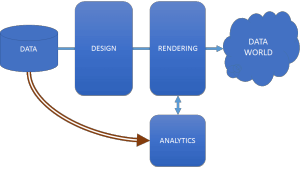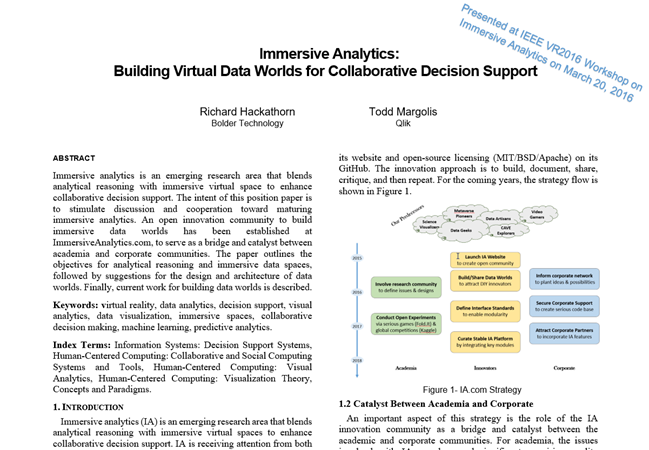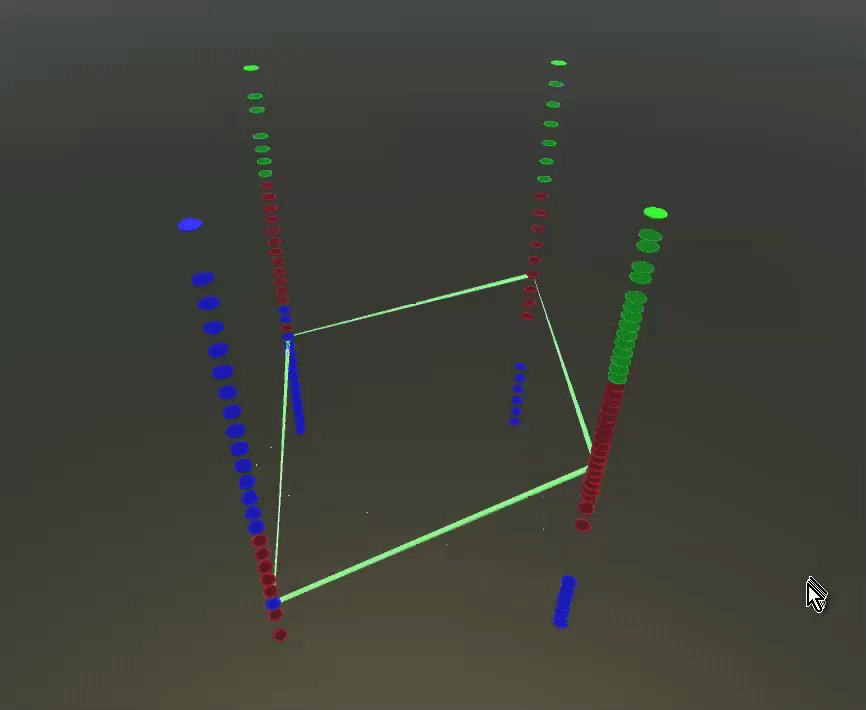What is Immersive?
…realistic feeling of being there or being present within a virtual space. With multi-person immersive spaces, it becomes being there with others, allowing for shared experiences and collaborative actions. Immersion is not new, occurring frequently around campfires for thousands of years. So, technology is not an essential ingredient. The challenge is determining whether immersion is effective for understanding a concept or performing a task. …more

What is Analytics?
…augmentation of human judgments with analytical reasoning to generalize beyond known data. Without analytics, we can not handle the truth embedded in big data, being unable to comprehend its significance. This forces a symbiotic relationship of human and computer, with the balance sliding toward the latter. An analogy is eyeglasses, where the eyeglasses were telling the person where to go. Analytics should be turned inside out so that the person can constantly sense the analytic process. …more

Immersive Analytics is…
…being there with others to generalize beyond data known about a system. The there is an unlimited immersive virtual space where scale and time are malleable. The others are persons with a common interest to understand and collaborative toward various goals. The generalizing is the augmentation of human judgment with analytic reasoning in a healthy symbiotic relationship. The system is the unit of analysis, the whole context within which insights and actions can be compared and contrasted.
The objective is to design and build data worlds that are immersive + analytical. …more
Defining Data Worlds
Data worlds are immersive virtual spaces whose objects are procedurally generated by data and represent the causal relationships within a complex system. The approach is to bring all the necessary data, into one context, to understand and manage that system, whether big or small. This contrasts from the usual data visualization analyses that focuses on one aspect of the system at a time.
Think of a data world as a well-designed themed park, where the system is fully laid out over a vast plain with data being refining at various places. The spirit of data worlds is similar to the enterprise data warehouse, whose focus is the entire organization across functional areas, as a single integrated system.
Potential venues (or usage modes) are: Visitor Gallery as a static viewpoint of a specific topic, Museum Tour as guided path to observe, Explorer for single discovery objective, Analysis Team to find collaborative insights, and Control Room for monitoring system behavior. …more
Designing Data Worlds
A key challenge is defining the design principles for data worlds, an initial set of which is: Engaging, Persistent, Information-Rich, Interactive, and Collaborative.
A basic architecture for a data world consists of a left-to-right flow of metadata from the data sources to the data world.  The Design module adds the design configuration for that data world, created earlier by the World Designer utility. The Render engine generates the virtual objects with the proper appearance, behavior, and position and renders those objects within the 3D space. Actual data flows only to the remote Analytics module where various routines push analysis results as metadata into the Render engine. …more
The Design module adds the design configuration for that data world, created earlier by the World Designer utility. The Render engine generates the virtual objects with the proper appearance, behavior, and position and renders those objects within the 3D space. Actual data flows only to the remote Analytics module where various routines push analysis results as metadata into the Render engine. …more
Building Data Worlds
The best way to advance the thinking about IA is to build and build data worlds. Only through trying various combinations of design styles, rendering engines, rendering displays, and open datasets, will we discover practical use cases and effective design strategies.
For experimenting and sharing, the approach is to create several Hello Data Worlds apps, which are minimal architectures spanning various combinations and collected into a gallery of downloadable examples. Initial combinations are:
- Three.js using HTML5 WebGL with variations of Qlik Sense analyses.
- Unity3D with parallel coordinates using SQL-generated statistics, linear regression using scikit-learn Python, and nPath sankey analyses using Teradata Aster Express.
Other combinations of rendering engines could include: multi-user metaverses (High Fidelity, virBELLA, OpenSimulator) plus open sandox worlds (MineCraft). Combinations of analytic modules could include: cloud analytics (Spark/DataBricks, AWS Analytics MR) plus analytic flow IDE (RapidMiner, Alteryx). …more





